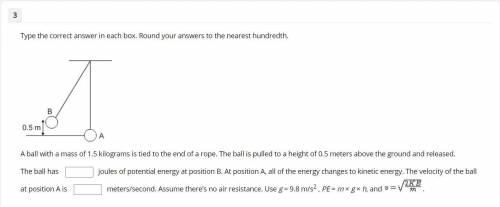
Physics, 17.04.2021 06:20 sassyunicorngir
Type the correct answer in each box. Round your answers to the nearest hundredth.
A ball with a mass of 1.5 kilograms is tied to the end of a rope. The ball is pulled to a height of 0.5 meters above the ground and released.
The ball has
joules of potential energy at position B. At position A, all of the energy changes to kinetic energy. The velocity of the ball at position A is
meters/second. Assume there’s no air resistance. Use g = 9.8 m/s2 , PE = m × g × h, and .


Answers: 1


Another question on Physics

Physics, 22.06.2019 10:50
Asubject in a clinical research trial experiences a serious, unanticipated adverse drug experience. how should the investigator proceed, with respect to the irb, after the discovery of the adverse event occurrence? a. do not report the adverse drug experience to the irb since it is a common adverse experience.b. report the adverse drug experience to the irb only if there are several other occurrences.c. report the adverse drug experience as part of the continuing review report.d. report the adverse drug experience in a timely manner, in keeping with the irb's policies and procedures, using the forms or the mechanism provided by the irb.
Answers: 1

Physics, 22.06.2019 13:30
The period of a pendulum varies directly as the square root of the length of the pendulum and inversely as the square root of the acceleration due to gravity. find the period when the length is 144 cm and the acceleration due to gravity is 980 cm per second squared, if the period is 7pi seconds when the length is 289 cm and the acceleration due to gravity is 980 cm per second squared.
Answers: 2

Physics, 22.06.2019 15:30
Aforce of 100 newtons is used to move an object a distance of 15 meters with a power of 50 watts. find the work dine and the time it takes to do the work
Answers: 1

Physics, 22.06.2019 17:00
Two manned satellites approaching one another at a relative speed of 0.550 m/s intend to dock. the first has a mass of 2.50 ✕ 103 kg, and the second a mass of 7.50 ✕ 103 kg. assume that the positive direction is directed from the second satellite towards the first satellite. (a) calculate the final velocity after docking, in the frame of reference in which the first satellite was originally at rest.(b) what is the loss of kinetic energy in this inelastic collision? (c) repeat both parts, in the frame of reference in which the second satellite was originally at rest. final velocity(d) loss of kinetic energy = ?
Answers: 2
You know the right answer?
Type the correct answer in each box. Round your answers to the nearest hundredth.
A ball with a mas...
Questions

Social Studies, 21.02.2021 15:40

Mathematics, 21.02.2021 15:40

Social Studies, 21.02.2021 15:40



English, 21.02.2021 15:40



Mathematics, 21.02.2021 15:40


Advanced Placement (AP), 21.02.2021 15:40

Business, 21.02.2021 15:40


Spanish, 21.02.2021 15:40


Mathematics, 21.02.2021 15:40

Mathematics, 21.02.2021 15:40

German, 21.02.2021 15:40

Mathematics, 21.02.2021 15:40

Mathematics, 21.02.2021 15:40




